Into the urban core, living on gas fumes: Gaylen Hansen
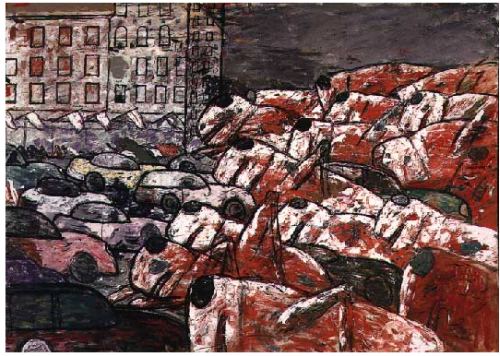 Silky as perfumed employees of the pleasure quarter: Sarah Emerson.
Silky as perfumed employees of the pleasure quarter: Sarah Emerson.
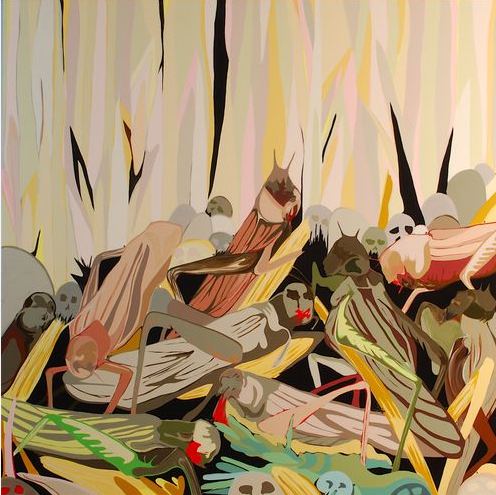 Why swarm?
Why swarm?
Regina Hackett takes her Art to Go
Into the urban core, living on gas fumes: Gaylen Hansen
 Silky as perfumed employees of the pleasure quarter: Sarah Emerson.
Silky as perfumed employees of the pleasure quarter: Sarah Emerson.
 Why swarm?
Why swarm?
Opening Friday night at the Henry Gallery as part of an open house, 6-11, is
I Myself Have Seen It: Photography by Kiki Smith, curated by Elizabeth Brown.
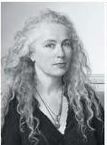 When Smith spoke Thursday night to a packed house, many who showed up probably thought she’d talk about the exhibit. She touched on it but turned away, saying only that she began using photographs of her work as work when she needed to fill a space and improvised the photos into a kind of serial narrative.
When Smith spoke Thursday night to a packed house, many who showed up probably thought she’d talk about the exhibit. She touched on it but turned away, saying only that she began using photographs of her work as work when she needed to fill a space and improvised the photos into a kind of serial narrative.
Instead, in a voice that’s close to music with her curly gray hair streaming around her, she digressed. Each topic became a stepping stone to different parts of her mental garden.
The University of Washington did not help. Her slides were constantly out of focus and did not improve unless she asked the person in booth to do something. The lights were too bright to see the slides well, and the microphone during the questions period was unreliable. She remained serene. Gently, she said about one slide, “I don’t think you can see it, and it’s upside down.”
Below, in her own words, random quotes from the endlessly quotable Ms. Smith.
I don’t know what I’m going to say. I hope to jar my mind into having a thought. I basically don’t have any necessity to talk in my life.
My greediness, in the end, is to show you something completely
different.
Refuse to be owned by style. Do not be strangled by your own history. Flip the meaning. Explore the facets. What holds up for you at one time doesn’t have to hold up for the rest of your life. Your work can be conflicted. I used to be interested in how much skin a body had, how much blood. I’m not as exact now.
You get to cannibalize your own work to get as much mileage out of it as you
can. While creativity is given to you freely, it’s not given every day.
The feminist moment radically changed what art could be. I looked to Nancy Spero, who worked on paper, made prints and made art out of being a woman; Eva Hesse, who made the body abstract, and Barry Le Va, who is so good at the difference between two dimensions and three dimensions. When I was young, I’d see something by Bruce Nauman and want to throw in
the towel. A few days later, I’d think, there’s still a little space he
isn’t in.
You can’t wait around for other people to want or need you work. There were times that making paperweights kept me afloat financially. I wanted to be an artist whose work would wind up (on sale) at Macy’s.
The only time my father (Tony Smith) touched his sculpture is when a photographer came and asked him to put his hands on it.
Richard Tuttle is our greatest American artist, maybe, according to me.
I hate all this junk they teach in art school, where you’re supposed to
know what you’re doing. It’s only in the unknown that we get to blossom.
Why her colors tends to be muted:
I was around the process sculptors, like Richard Serra and Alan Saret. Color seemed indulgent. That’s my American Puritanism, I think. I could change that.
On collaborations:
I collaborate with people when they do want I want them to do, people who have some
super facility in printmaking or blowing glass. They have something in their bodies I’ll never have in my body.
A few selections from her book, her 20th century. (Previous post)
Guillaume Apollinaire, from Shadow:
As a hundred furs make only one coat
As those thousands of wounds make only one newspaper article…
Siegfried Sassoon, from Repression of War Experience:
You’re quiet and peaceful, summering safe at home;
You’d never know there was a bloody war on!…
Osip Mandelstam, from The Stalin Epigram:
He rolls the executions on his tongue like berries.
He wishes he could hug them like big friends from home.
George Oppen, from Route, Part 5:
There was an escape from that dilemma, as, in a way, there always is. Pierre told me of a man who, receiving the notification that he was to report to the German army, called a celebration and farewell at this home. Nothing was said at that party that was not jovial. They drank and sang. At the proper time, the host got his bicycle and waved good-bye. The house stood at the top of a hill and, still waving and calling farewells, he rode with great energy and as fast as he could down the hill, and, at the bottom, drove into a tree.
Bertolt Brecht, Motto
This, then, is all. It’s not enough, I know
At least I’m still alive, as you may see.
I’m like the man who took a brick to show
How beautiful his house used to be.
Joseph Brodsky, from Elegy:
A ruin’s a rather stubborn
architectural style…At sunrise, when nobody stares at one’s face, I often
set out on foot to a monument cast in molten
lengthy bad dreams. And it says on the plinth “Commander
in chief.” But it reads “in grief,” or “in brief,” or “in going under.”
Irina Ratushinskaya, from Try to cover your shivering shoulders
‘You must die’ – but is that so distressing?
You just feel slightly sick,
As you enter the stain on the wall.
W. H. Auden, from September 1, 1939
I and the public know
What all schoolchildren learn,
Those to whom evil is done
Do evil in return…Faces along the bar
Cling to their average day:
The lights must never go out,
The music must always play,
All the conventions conspire
To make this fort assume
The furniture of home;
Lest we should see where we are,
Lost in a haunted wood,
Children afraid of the night
Who have never been happy or good.
Benjamin Peret, from Hymn of the Patriotic War Veterans
Even though I threw down my rifle butt
The Tauben still spit in my eye
that’s how I got decorated
Long live the republicI got rabbit punches in the ass
I was blinded by goat turds
asphyxiated by my horse’s dung
then they gave me the Cross of Honor
Paul Celan, from Black Fugue
we shovel a grave in the air there you won’t lie too cramped
A man lives in the house he plays with his vipers he writes
he writes when it grows dark to Deutschland you golden hair
Marguerite…he writes it and steps out of doors and the stars are all sparkling
He whistles his hounds to come close
he whistles his Jews into rows has them shovel a grave in the ground
he orders us to strike up and play for the dance…A man lives in the house he plays with his vipers he writes
he writes when it grows dark to Deutschland you golden hair
Marguerite
you ashen hair Shulamith we shovel a grave in the air….
Celan’s poetry anchors the work of Anselm Kiefer, especially Black Fugue, with its reoccurring images of the blond German (your golden hair Marguerite) and the Jewish dead (your ashen hair Shulamith)…(Images via)
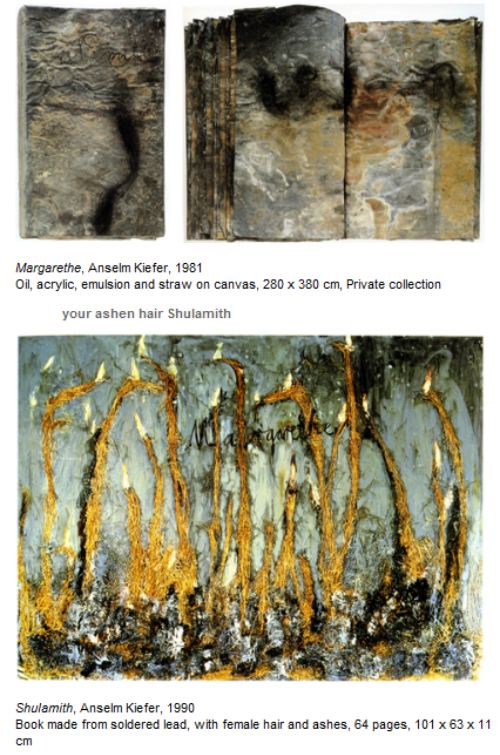
From BBC News:
Even though President Barack Obama promised during his election campaign to call a mass murder a genocide when it is/was genocide, his administration has asked a Congressional panel not to do so, fearing to insult an ally.
The Obama administration has called on a Congressional panel not to describe the killing of Armenians by Turkish forces during World War I as genocide.
US Secretary of State Hillary Clinton urged the chairman of the House Foreign Affairs Committee to hold off a vote on the issue, the White House said.
She said the non-binding resolution would harm talks between Turkey and Armenia.
The resolution is fiercely opposed by Turkey, a key ally of the US.
In 2007, a similar resolution passed the committee stage, but was shelved before a House vote after pressure from the George W Bush administration.
Turkey has warned of consequences for US-Turkey ties if the latest resolution is passed.
During his election campaign President Barack Obama promised to brand the mass killings genocide. (more)
Why dredge up past evils? Given the precarious state of the world, isn’t getting along with a valued ally more important than quibbling about history’s record? There is no country on earth whose citizens can claim a history free of human rights abuse. Why pick on Turkey?
As an answer, Carolyn Forche edited a collection of 20th-century world poetry: Against Forgetting, Twentieth-Century Poetry of Witness, published in 1993.
Forche:
Any twentieth-century history of human rights and genocide must begin with the massacre of Armenians, then the largest Christian minority population of Turkey. Between 1909 and 1918, approximately 1.5 million Armenians were massacred by order of the Ottoman Turkish government….Historians call it the first “modern” genocide,” because it appears to be the first instance of political mass murder made possible by advanced technology and modern communications implemented by a centralized state bureaucracy.
Days before the invasion of Poland, Hitler posed a question to his military cabinet:
Who, after all, speaks today of the annihilation of the Armenians?
Arshile Gorky, a little history:
Gorky fled (the town of) Van in 1915 during the Armenian Genocide and escaped with his mother and his
three sisters into Russian-controlled territory. In the aftermath of the
genocide, Gorky’s mother died of starvation in Yerevan
in 1919. (more)
Gorky, The Artist and His Mother (ca.1926-1936). Oil on canvas. 60″× 50″. Collection, Whitney Museum of American Art
 Gorky, How My Mother’s Embroidered Apron Unfolds in My Life Oil on Canvas 1944, Collection, Seattle Art Museum (image via)
Gorky, How My Mother’s Embroidered Apron Unfolds in My Life Oil on Canvas 1944, Collection, Seattle Art Museum (image via)
 Part 2, the poems, here.
Part 2, the poems, here.
If geometry were capable of taking its own rules lightly, mathematics would be at home in the paintings of Alexander Kroll.
They look as if they long to be grids but cannot pass the sobriety test.
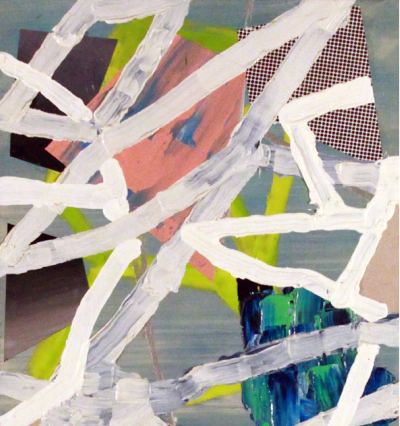 Kroll works small, usually in oil and enamel but occasionally with some element of collage. Ambitious paintings that span no more than two joined hands used to be unusual, back when Thomas Nozkowski was consistently underrated for producing them. He said a single 16 x 14 inch painting could fill a wall but didn’t insist on having a wall for each one, and that was also held against him. (No ego, no glory.)
Kroll works small, usually in oil and enamel but occasionally with some element of collage. Ambitious paintings that span no more than two joined hands used to be unusual, back when Thomas Nozkowski was consistently underrated for producing them. He said a single 16 x 14 inch painting could fill a wall but didn’t insist on having a wall for each one, and that was also held against him. (No ego, no glory.)
Since the mid-1990s, thanks in part to Nozkowski, big no longer has a corner on best. If we’re not quite at William Blake’s definition of enlightenment, to see eternity in a grain of sand, we generally accept that a painting of modest dimensions can possess an enormous sense of scale.
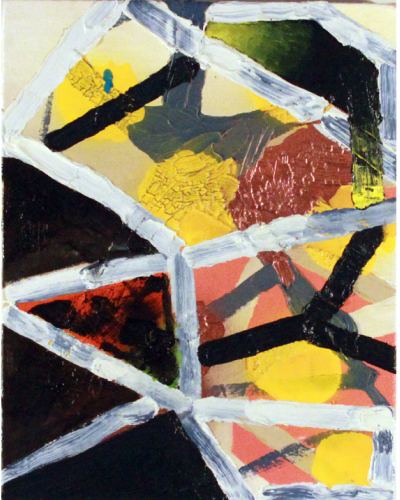 Some look at Kroll’s work and see nothing but sources: He owes everything to Gerhard Richter, they say. He’s Terry Winters without the seedpods. Doesn’t Tomory Dodge do this better?
Some look at Kroll’s work and see nothing but sources: He owes everything to Gerhard Richter, they say. He’s Terry Winters without the seedpods. Doesn’t Tomory Dodge do this better?
A friend asked that question about Dodge at Kroll’s James Harris Gallery opening, not loudly, to be boorish, but in the spirit of evidence proffered toward a conclusion already reached: not that good. I could have said I thought Dodge leaned more toward Richter and Kroll toward Nozkowski but didn’t. What I wanted to say was an unacceptable question: What is it that you are seeing? Can you see these particular paintings? Can you forget pedigree for a moment and let the moments the paintings themselves create carry you toward their own conclusions?
Broad yet broken diagonals crisscross the surface, creating a foreground that serves as a failed barrier, a collapsed grid. Behind it is the kind of push-pull the Abstract Expressionists used to advocate, an animated, energy exchange carried by color.There’s nothing earth-shaking in Kroll’s premises, but their elaborations are a rare and engrossing pleasure.
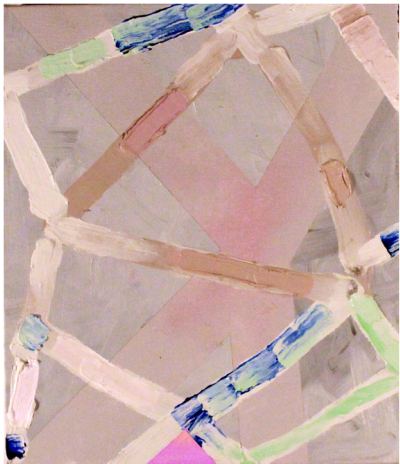 Through March 27.
Through March 27.
Don’t let this happen to 4Culture, the vital center of public art patronage in the city.
 From Anna Callahan :
From Anna Callahan :
(Image via)
There are less than two weeks left in this session and we need legislation to move. If bills are not passed this year, we just heard confirmation that 4Culture is going to start planning dramatic staff, services and funding programs cuts that will begin as early as January, 2011.
This is the first this reality has truly sunk in and we’re panicking.
Since the session started in January, we’ve seen at least 6 different bills proposed that would generate the support needed for 4Culture to continue to thrive.
Unfortunately NONE of these bills has successfully moved through both the House and the Senate and time is running out.
What we need now is for every arts and heritage advocate in the state to write to their legislators with a general letter of support in the next few days.
Even if you’ve already written a letter supporting specific bills, we need one last push to make sure that legislators understand that whatever name and number you put on the bill, we need ARTS and HERITAGE funding to be secured THIS YEAR.
Please ask friends and family to do the same. Senators and Reps from all over the state will get to vote on this issue, so we need non-king county legislators to understand that their constituents are excited about strong funding.
Thursday night, 6-8, is a chance to participate in a pro-4Culture laptop rally in Pioneer Square. The 4Culture Gallery? Best guess is, it’s going down, unless funding comes through at the last minute.
If you’re out and about for First Thursday, you can drop in, write a letter and be on your way. AtCaffe Vita in the Tashiro Kaplan building, 125 Prefontaine Pl S. (How to participate without leaving home, here.)
A few days ago, idling away the time it takes to brush my teeth, I thought, Seattle Center needs to replace its now-defunct fun forest with an art park inspired by the carny world. Hence, this post, Replacing the Fun Forest At Seattle Center.
A version of that is poised to happen. Jen Graves noted today that a large Chihuly Museum is slated for the spot. In her reaction, City Council member Sally Bagshaw proves she isn’t living on earth with the rest of us:
“I took one look and said, ‘If that’s something you have to pay some money to go see, then that really isn’t right,’ because I want Seattle Center to be Seattle Central Park, where you can go even if you don’t have money.
Ever been to the fun forest, Sally? Many’s the time I’ve dropped $40 there while trying hard not to, as the children in my charge become more desperate to experience the fun they think they should be having.
Chihuly will be able to fill fun forest shoes with his own kind of carnival barker. More later.
(Image via)
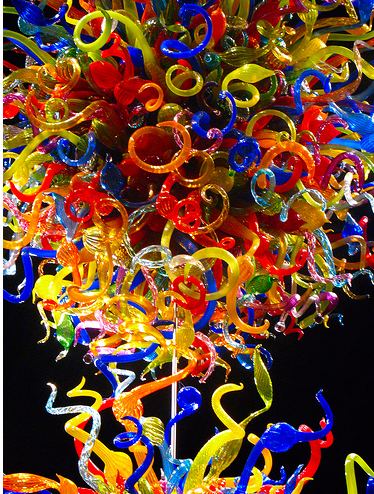
Jessica Powers‘ boyfriend works in a gallery. To make certain the magnitude of his personal good fortune doesn’t slip his mind, his co-workers have taken it upon themselves to preemptively remind him: “Don’t screw this up.”
She does everything well, including just being in a room. When she’s in a room with you, everything else in the room (including you) has a rare and purposeful shine. Like many in her generation (a hefty portion of the 1980s took place without her), Powers multitasks as curator, organizer and critic. To each endeavor she brings the depth of her concentration.
Here’s a passage from her review of Sol Hashemi‘s Object History Awareness at Gallery 4Culture:
There’s a current thread in philosophy that uses the sciences (math, physics, chemistry) as tools and metaphors for explaining entirely unscientific things about the world. The opposite of existential, objects don’t need to know how they interact with other objects or events or conditions, they’re simply always doing something.
Always playing, always passing time, always in contact or out of it. This is how Sol’s art feels – it is proof that a piece of art bent or folded or creased or left to lie has just as much relation to the space it is in and the people who see it and the currents of air that pass over it and to everything within and without. If you know better, or get bumped just right, you’ll literally feel the web – the things you can do that he’s done, the things that he’s done so you don’t have to, the things that his creations (are they even his?) are doing, and the entirely unrelated clashes of conditions and events and objects on the street, in the gallery, stacked in the studio. (more)
My Hashemi review here. She’s inside the experience, while I, an incorrigibly non-participating observer, am not. She and a few friends run the exhibition space known as TARL in her basement. Rob Smith’s installation concludes there on Saturday.
Other news:
How to “wrestle with distinctive, battered American ideals” – Christopher Knight reviews American Stories: Paintings of Everyday Life, 1765-1915 at the Los Angeles County Museum of Art, here, excellent as usual.
More Knight: Toyota of Hollywood faces a crises of context, here. Directly across the street from the company that makes cars with sticky accelerators and faulty brakes is the Museum of Death.
 Judith H. Dobrzynski reports on thuggery against artists in
Judith H. Dobrzynski reports on thuggery against artists in
China, here.
Golden egg in hand, developers want to kill the goose as police arrest (who else?) the artists. (Support Human Rights in
China. It’s a stellar organization that works every day to move a
mountain.)
Amazing story about how lightly old journalism takes its responsibilities when on a digital platform from music critic Larry Blumenfeld on
NAJP’s ARTicles
blog:
Last week, someone pointed out to me that
they’d found a piece of mine for the New Orleans Times Picayune on the
paper’s site, but underneath the byline of some woman I’ve never met.
Huh? My inquiry was met with this:
“We “upgraded” our blogging platform in
the fall, and when we did, the bylines switched to the name of the
person who posted the story – usually XXXXX, the features online
coordinator. Impossible to correct them all. I’ll see if she can get to
this one.”
I’ve deleted her name, nor need I
mention the editor, a genial guy who didn’t take the buyout. And my
polite demand for corrections to my work (more than just the one piece)
was heeded. (What about all those other bylines that didn’t get fixed?)
I’m sure there was nothing intentional going on, but there was also no
apparent alarm at such a serious glitch. Does anything beyond “getting
the content up” matter online? This one I didn’t see coming.
Related:
Nick Simmons, son of Gene, finds the cost of alleged plagiarism is
high, thanks to the sounding board of the Web, here.
Greg.org on Gerhard Richter wallpaper, here. By a wide margin, my favorite wallpaper is Kelly Mark‘s: – (Auden – In the prison of his days/Teach the free man how to praise)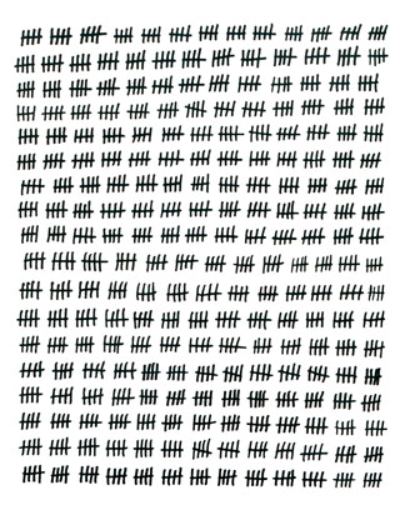 Finally, Kenneth Baker interviews Robert Irwin, the question addict, here.
Finally, Kenneth Baker interviews Robert Irwin, the question addict, here.
I realized that if I stayed in the studio I’d probably just do things similar to what I’d learned to do. And I loved being in the studio, it’s a great refuge for an artist, but I decided to divest myself of all those investments I’d made. … For a couple of years, I just wandered around in the Southwestern desert because there you really can get away from objects. … One of the things I was doing was questioning the whole system of signs to which art objects belong. I’ve since been trying to make the case that the reason art gets done is to step outside the system of signs, to work phenomenologically. … Mine is really a philosophical inquiry. I’ve become a question addict.
Jen Graves‘ article, The Vancouver Problem, continues to unfold in our lives. Although she wrote it nearly a year ago, its effects are still being felt, most recently in a panel discussion at the University of Puget Sound in Tacoma. (March 8, 7 p.m. at the Schneebeck Concert
Hall, free admission.)
Panelists are tip top.
1. Scott Watson, director/curator of the Morris and Helen Belkin Art Gallery, professor in the Department of Art History and director and graduate advisor for the Critical Curatorial Studies Program at The University of British Columbia
2. Jonathan Middleton, Vancouver-based artist, director/curator of the Or Gallery, sessional instructor at Emily Carr University of Art and Design, and a founding member of the Projectile Publishing/Fillip Review
3. Liz Magor, Vancouver-based artist and associate professor at Emily Carr University of Art and Design
4. Rock Hushka, curator of contemporary art, Tacoma Art Museum
5. Matthew Offenbacher, Seattle-based artist and editor of La Norda Specialo
6. Jen Graves of course, art critic for The Stranger and adjunct faculty in art
history at Cornish College of the Arts
Issues will include but are not limited to:
1. Effects of governmental funding for the arts on cultural production
2. Geographical location in relation to individual and cultural senses of identity
3. Distinct relationships to the broader, global art world
4. Regional art histories and legacies
Graves suggested that Vancouver might be more of fertile terrain than other points Northwest.
Say organizers:
The forum’s purpose is to enhance cross-border communication and consider broader questions of identity in the age of globalization.
I had a few problems with Graves’ premise when it came out. Still, as a conversational catalyst, her piece can’t be beat.
an ArtsJournal blog


